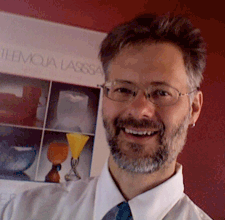Pilgrim Reindeer in Pisa, 1348
a free multimedia novel by
Thomas A. DuBois, University of Wisconsin-Madison
 |
Pilgrim Reindeer in Pisa, 1348 a free multimedia novel by Thomas A. DuBois, University of Wisconsin-Madison |
|
|
|
Part III. Italy. 49. The Chapel of San Bartolomeo [March 18, 1348]
In this chapter, I wanted to underscore the massive difference in worldview that separates Bávlos and Buonamico. I aimed to express it in part through their different views of hunting, but also through a contrast between two worship spaces: the grand Church of the Most Holy Annunciation—eventually one of the signature pieces of the Renaissance, placed in the same square as Brunelleschi's grand Foundling Hospital—and the humble little mountain chapel that one may find when one rambles along the winding roads of Mount Morello. The legendary painter of the Annunciation was indeed named Bartolomeo, and the chapel on the mountain is indeed named San Bartolomeo. But what happened to the actual brother after creating the painting in downtown Florence is not known. I simply imagined what it would be like to have been such an artist and placed him in this chapel as a believable scenario. It is certainly true that modern human witnesses of grand Marian apparitions like Lourdes and Fatima have had difficult times living ordinary lives after such events, so I thought it would stand to reason that a fourteenth-century artist might have difficulties as well. And I wanted to come up with a good story about why the saint in this fresco has a pig. It is actually St. Anthony who is more often depicted with a pig than St. Bartholomew—a reference to pig meat as a cure for ergotism as discussed in an earlier chapter. The fresco contains no inscription to identify the saint or the reason for his pig.